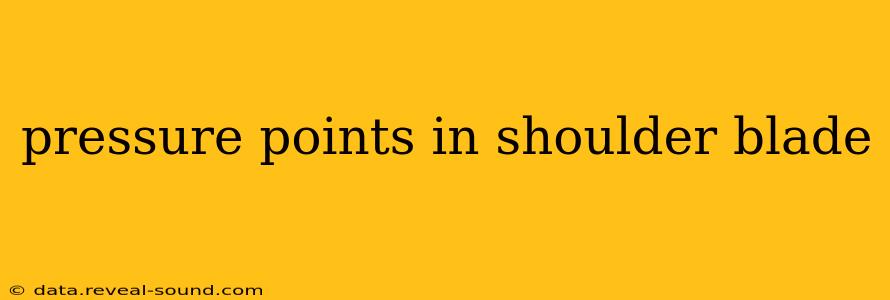The shoulder blade, or scapula, is a triangular bone located on the upper back. While not directly containing pressure points in the same way as, say, the hand or foot, several areas around and on the scapula are sensitive to pressure and can be manipulated for therapeutic benefits. Understanding these areas and the proper techniques is crucial to avoid injury. This article explores potential pressure points and their associated benefits and cautions. It is important to note that this information is for educational purposes only and does not constitute medical advice. Always consult with a healthcare professional before attempting any self-treatment.
What are the Key Areas of Sensitivity Around the Shoulder Blade?
There isn't a definitive list of "pressure points" on the shoulder blade in the traditional acupuncture sense. However, several areas are rich in nerve endings and muscles, making them responsive to pressure:
-
Between the Shoulder Blades: The area between the shoulder blades is often tense and tight, especially due to prolonged sitting or stress. Applying pressure here can release muscle tension and improve posture.
-
Upper Trapezius Muscle: This muscle runs from the base of the skull to the shoulder. Tightness in this area can cause neck and shoulder pain. Gentle massage and pressure can alleviate this.
-
Rhomboid Muscles: These muscles are located beneath the upper trapezius, connecting the scapula to the spine. They play a role in shoulder blade movement and posture. Pressure applied here can relieve tension and improve shoulder mobility.
-
Infraspinatus Muscle: This muscle is located on the posterior (back) side of the scapula. It’s involved in external rotation of the shoulder. Tightness can lead to shoulder pain and reduced range of motion. Careful pressure and massage can help release this tension.
-
Levator Scapulae Muscle: This muscle elevates the scapula and is often a source of neck and shoulder pain. Releasing tension in this muscle can be helpful.
What are the Potential Benefits of Applying Pressure to These Areas?
Applying appropriate pressure to the sensitive areas around the shoulder blade may offer several potential benefits, including:
-
Pain Relief: Relieving muscle tension and addressing trigger points can significantly reduce pain in the neck, shoulders, and upper back.
-
Improved Posture: Releasing tight muscles can improve posture and reduce strain on the spine.
-
Increased Range of Motion: Increased flexibility and reduced stiffness lead to better shoulder mobility.
-
Stress Reduction: Massage and pressure point techniques can promote relaxation and reduce stress levels.
-
Improved Circulation: Stimulation of these areas can help improve blood flow to the muscles and tissues.
How Can Pressure Be Applied Safely?
Several techniques can be used to apply pressure safely to these areas:
-
Self-Massage: Using your fingertips or knuckles, apply gentle, firm pressure to the tender areas. Avoid applying excessive force.
-
Massage Therapy: A professional massage therapist can identify and address trigger points and muscle tightness.
-
Foam Rolling: Foam rollers can be used to apply pressure to larger areas of the back, including the muscles around the shoulder blades.
-
Heat Therapy: Applying heat to the area before massage can help relax the muscles.
What are the Potential Risks and Cautions?
While generally safe, applying pressure to these areas carries some potential risks:
-
Injury: Applying excessive pressure can cause muscle strains or other injuries. Always start with gentle pressure and increase gradually.
-
Aggravation of Existing Conditions: If you have any underlying medical conditions, consult a healthcare professional before attempting self-treatment.
-
Incorrect Technique: Incorrect application of pressure can worsen the problem. It's essential to use proper techniques and seek professional guidance if necessary.
-
Ignoring Underlying Medical Issues: Pain in the shoulder blade area can be a symptom of serious underlying medical conditions. Do not self-diagnose or self-treat if you have persistent or severe pain.
Frequently Asked Questions
Q: Can applying pressure to the shoulder blade area help with headaches?
A: Yes, tension in the muscles around the shoulder blades can contribute to headaches, particularly tension headaches. Relieving this tension through massage or pressure point techniques may help alleviate headache pain.
Q: Are there specific pressure points for relieving shoulder pain?
A: While there aren't officially designated pressure points like on the hands or feet, focusing on areas of tension in the upper trapezius, rhomboids, infraspinatus, and levator scapulae muscles can be effective for pain relief.
Q: How often should I apply pressure to these areas?
A: The frequency depends on individual needs and response to treatment. Some people may benefit from daily applications, while others may only need it a few times a week. Listen to your body and adjust accordingly.
Q: What if the pain persists after applying pressure?
A: If pain persists or worsens, consult a healthcare professional to rule out any underlying medical conditions. They can help determine the cause of your pain and recommend appropriate treatment.
Remember, while applying pressure to the areas around the shoulder blade can be beneficial for pain relief and improved mobility, it’s essential to approach it cautiously. Consult with a healthcare professional before starting any new self-treatment regimen, especially if you have pre-existing conditions or experience persistent pain.
